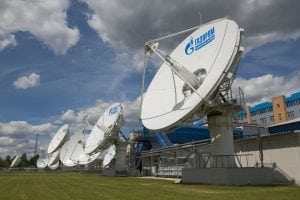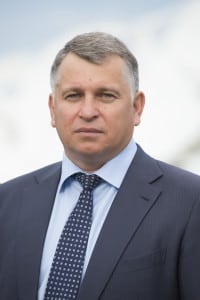Latest News
[Via Satellite 08-31-2015] Russian satellite operator Gazprom Space Systems (GSS) is intent on filling out its existing fleet of satellites in 2016. The company, which has 3.5 times more capacity in-orbit today than it did in 2012, aims to fill its four-satellite constellation by the close of next year.
“By the end of 2016 we plan to fully load our current satellites. That enables us to keep the high pace of the revenue growth comparable to the one reached in 2014,” Dmitry Sevastiyanov, director general of Gazprom Space Systems, told Via Satellite. “This year we start the new big investment cycle to renew and enlarge our satellite constellation. So the main investments will be accounted for the next two to three years.”
Gazprom Space Systems owns a young fleet of satellites, with the latest, Yamal 401, launching in December 2014. The operator’s next satellite is Yamal 601, which is set to replace the Yamal 202 satellite at 49 degrees east with a near-identical C-band service zone along with new Ka-band capacity. In April of this year Gazprom Space Systems began relocating the electrically propelled Yamal 300K satellite from 90 degrees east to 183 degrees east, where the spacecraft arrived in June. Clients from Yamal 300K have been “reloaded” onto Yamal 401, which is now at Yamal 300K’s former orbital slot.
Gazprom Space Systems relocated the satellite through a partnership with SES, where it is supported by the American teleport company U.S. Electrodynamics’ teleport in Brewster, Wash. At its new location, Yamal 300K covers Russia’s Far East, much of the Northern Pacific Ocean, and the West coast of North America where it is driving new business.
“This is not the first case of the companies’ partnership in terms of joint use of the existing orbital assets. Earlier in 2011, SES’ satellite Astra 1F was relocated into GSS’ orbital slot. This time SES provided us with the opportunity to occupy its orbital slot,” said Sevastiyanov.
He added that there were two primary reasons for the relocation: a dearth of high quality satellite capacity in its new footprint, and an increase in activity from GSS’ main shareholder, Gazprom, which is a major consumer of its satellite services. Sevastiyanov said Gazprom is currently planning a number of large gas projects in Eastern Siberia and in Russia’s Far East, such as developing new fields, building gas pipelines, and implementing the “Sila Sibiri,” or Power of Siberia, energy project.
“We have already signed the first contracts for Yamal 300K capacity and some of them are rather big,” Sevastiyanov hinted.
Yamal 300K also has a steerable beam for broadcast and Very Small Aperture Terminal (VSAT) services in any region of South-East Asia, Australia, New Zealand or island states of the Pacific.
Sevastiyanov said two thirds of Gazprom Space Systems’ satellite capacity is dedicated to Russia, with the remaining one-third concentrated in beams covering other regions. He pointed to Yamal 202, launched in 2004, as the satellite that first gathered international attention. The satellite is popular in Europe, the Middle East and Southeast Asia, he said, thanks to its wide C-band service zone, and has enough fuel to operate until at least June 2019. Yamal 402, located at 55 degrees east, covers the African and Middle Eastern markets. Sevastiyanov said the number of customers on this spacecraft continues to climb despite the high level of competition.
Gazprom Space Systems sees the traditional drivers of television, broadband and backhaul continuing to fuel demand for satellite services in the years to come. However, Sevastiyanov also mentioned the operator is looking into new markets as well.
“We provide aerospace monitoring services — they don’t bring a lot of revenue now, but in our opinion has a great future. We are planning to create our own constellation of Earth observation satellites. In addition, we are going to build our own spacecraft assembling facilities and start business in the sphere of assembling, integrating and testing communications and observation satellites,” he said.
Sevastiyanov added that the operator is also preparing to support new broadcast technologies as the video market evolves.
“In general, based on our Russian experience we see that [High Definition] HD TV gathers pace and I’d like to note that our ground facilities are technically ready to support growing demand on these services. We already have some HD channels on our satellites. With respect to 4K technology, we anticipate such a channels appearance on Yamal satellites. This year we are going to test in our television center the hardware-supporting 4K format,” he said.
Gazprom Space Systems recently completed the consolidation of its ground assets at its telecommunications center in Shchelkovo, Moscow. Sevastiyanov said the operator now has the Mission Control Center (MCC) for all Yamal satellites, the hubs, uplink stations, satellite capacity monitoring facility and Network Operations Center (NOC) located in one place. As the operator expands its orbital infrastructure, Sevastiyanov said it will continue to develop ground infrastructure as well. Gazprom Space Systems has hubs from Advantech Wireless, Newtec, Gilat, Eastar and Hughes platforms today.
“The next step in our ground infrastructure development is building of a Ka-band hub station, which, together with Yamal 601, will form a system of broadband access for the consumer market,” he said.
As Gazprom Space Systems continues to grow, it must also face the challenges associated with the decline in the value of the ruble. Sevastiyanov said the operator interacts regularly with its customers, suppliers and financial institutions to reduce the risks associated with ruble fluctuations, and is seeking to bolster the number of international customers on its fleet. To ensure stability in both financial obligations and revenues, Gazprom Space Systems is pursuing a balance between foreign currencies and the Russian currency, he said.
Get the latest Via Satellite news!
Subscribe Now
